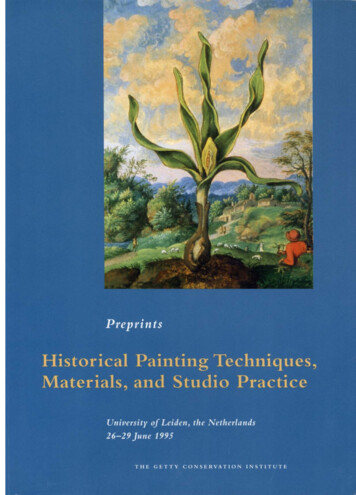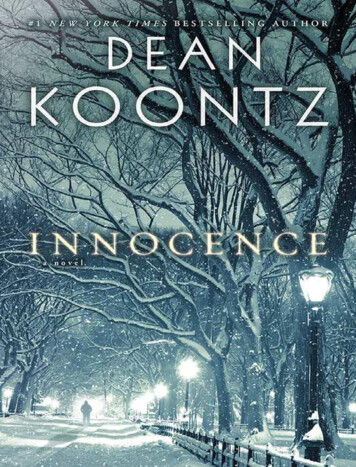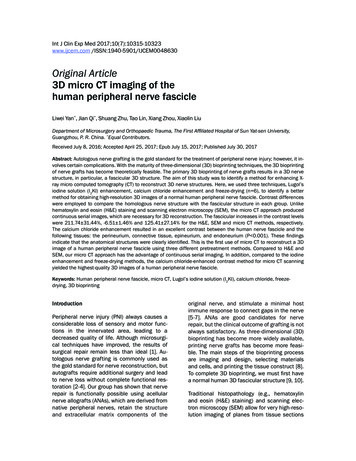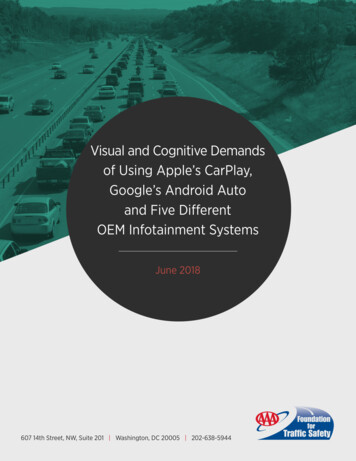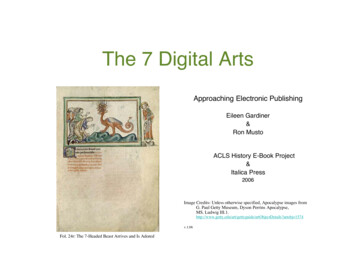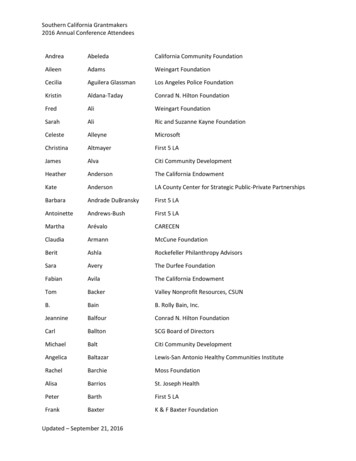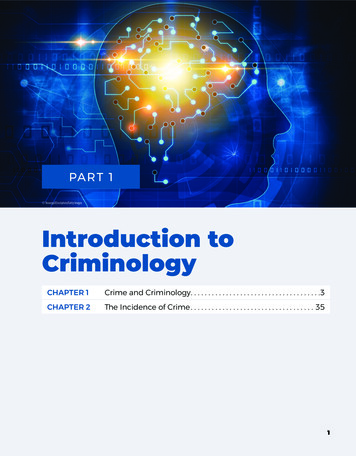
Transcription
PART 1 Nevarpp/iStockphoto/Getty ImagesIntroduction toCriminologyCHAPTER 1Crime and Criminology. . . . . . . . . . . . . . . . . . . . . . . . . . . . . . . . . . . . . 3CHAPTER 2The Incidence of Crime. . . . . . . . . . . . . . . . . . . . . . . . . . . . . . . . . . . . 351
Tithi Luadthong/ShutterstockCHAPTER 1Crime and CriminologyCrime and the fear of crime have permeated the fabric of American life.—Warren E. Burger, Chief Justice, U.S. Supreme Court1Collective fear stimulates herd instinct, and tends to produce ferocity toward those who are not regarded asmembers of the herd.—Bertrand Russell2OBJECTIVEScriminology, and understand how this field of study relates to other social science disciplines. Pg. 4 Definethe meaning of scientific theory and its relationship to research and policy. Pg. 8 Understandhow the media shape public perceptions of crime. Pg. 19 Recognizethe criteria for establishing causation, and identify the attributes of good research. Pg. 13 KnowUnderstandthe politics of criminology and the importance of social context. Pg. 18 Define criminallaw, and understand the conflict and consensus perspectives on the law. Pg. 5 Describe the variousschools of criminological theory and the explanations that they provide. Pg. 9 IntroductionCrime is a social phenomenon that commands theattention and energy of the American public. Whencrime statistics are announced or a particular crimegoes viral, the public demands that “something bedone.” American citizens are concerned about theirown safety and that of their families and their possessions. For example, Gallup regularly polls Americanson whether they feel as though crime in the UnitedStates has gotten better or worse in the past year. Inalmost every poll since 1989, a majority of people feltthat crime had increased.3 This was true even in yearswhen actual crime rates declined substantially. Becauseof the public’s concern about the safety of their communities, crime is a perennial political issue that candidates for political office are compelled to address.Dealing with crime commands a substantial portion of the country’s tax dollars. Criminal justice system operations (police, courts, prisons) cost Americantaxpayers over 270 billion annually. That equates toabout 900 per citizen.4 Much of this cost is due tothe use of prisons and jails. Despite making up lessthan 5% of the global population, the United Statesnow holds almost 25% of the world’s inmates.5As these statistics indicate, crime is an importantsocial issue. Further, how policymakers deal withcrime (via crime policy) can have enormous social3
4Chapter 1 Crime and Criminologyand financial implications. Indeed, the high incarceration rates in America are rooted in policy changesmade by states and the federal government throughout the 1980s and 1990s. A basic tenet of this textis that a combination of theory and research canhelp provide direction to crime policy. The chaptersin this book attempt to organize ideas in order toexplain criminal behavior. This includes the factorsthat contribute to crime and the social reactions tocrime. In short, this book explores the discipline ofcriminology.What Is Criminology?Simply put, criminology is the scientific study ofcrime. More broadly, Edwin Sutherland describedcriminology as the study of lawmaking, law- breaking,and the response to law-breaking.6 Some scholarsfurther distinguish criminal justice from criminology. Here, Sutherland’s definition is subdivided intotwo related fields, where criminology focuses onlaw-breaking (i.e., the nature, extent, and causes ofcrime), and criminal justice focuses on the response(i.e., policing, courts, and corrections) to criminalbehavior. Scholars interested in criminal justice, forexample, may study the causes and consequencesof prison crowding or the effectiveness of different p olicing models. Of course, there is a relationship between criminology and criminal justice. Theresponse to crime depends largely on one’s view ofthe causes of crime. For this reason, many criminologists work in both of these areas.Another discipline related to criminology is thestudy of deviance. A “deviant” is anyone who violatessocial norms. Norms are guidelines that define formembers of a society the types of behaviors that areappropriate or inappropriate in certain situations;they are classified as folkways, mores, and laws, basedlargely on the response to their violation.7 Folkwaysare norms against actions (e.g., nose picking) thatmay evoke a snicker or some teasing as a response.Violations of a society’s mores (e.g., teen pregnancy)evoke a more serious response from others. Laws arenorms that have been codified, and the response toviolations comes from formal government agencies.Therefore, although some deviant behavior is criminal, deviance can also include acts (e.g., violatinggender norms, cheating on an exam) that are notdefined as crimes. Deviance scholars are often interested in how deviant behaviors come to be criminalized; that is, they focus on the “lawmaking” aspect ofSutherland’s definition.Norms often change over time. Not long ago, tattooswere considered a mark of deviance.Criminology and AcademicsUntil recently, people with an academic interest incriminal behavior sought degrees in social science disciplines such as anthropology, psychology, economics, law, political science, ethics, and sociology; thus,a student might earn a degree in sociology with anemphasis on deviance and crime. Although some people still study crime through other disciplines, mostuniversities now offer degrees in criminology or criminal justice. Moreover, many universities have separate criminology departments, divisions, or schools.In that sense, criminology has emerged as a distinctsocial science discipline.This emergence has been partial, however, and abit awkward. In part, this is because unlike other socialscience disciplines, criminology is organized arounda class of behaviors (crime) rather than a particularway of understanding these behaviors. Social sciencedisciplines tend to be organized around common assumptions, guiding insights, and specific researchmethodologies.8 For example, psychologists generallyseek to understand the mental processes that explainhuman behavior, while sociologists emphasize the roleof social institutions and processes. Within any socialscience discipline, “crime” is only one type of humanbehavior that attracts interest. A psychologist mightalso be interested in intelligence, a political scientist
A Brief History of the Criminal Lawin voting behavior, and a sociologist in explainingsocial movements. One might expect, therefore, thatcriminology would be multidisciplinary in nature.This is indeed the case—many disciplines have made contributions to the scientific study of crime. Someof the earliest scientific theories of crime came frombiologists and psychologists. Few would dispute thefact, though, that sociology has had the largest impacton the study of crime.Throughout most of the 20th century, sociologists were prominent in social scientific discourseabout criminal behavior. The roots of this contribution can be traced to members of the sociologydepartment at the University of Chicago. ErnestW. Burgess, W. I. Thomas, and a host of othersociologists created a body of research methodology, research findings, and theory related to crimethat came to be called simply the “Chicago School ofCrime.”9 During the 1930s, Edwin Sutherland, a student of the Chicago School sociologists, became thedominant advocate of criminology with his theoriesof differential association and white-collar crime. Atabout the same time, Robert K. Merton, a ColumbiaUniversity sociologist, developed the sociologicaltheory of anomie. This theory has been utilized tostudy different forms of crime, from street crime toorganized crime.Sociologists, and those with advanced degreesin criminal justice and criminology, continue to havea major influence on the study of crime. In the 21stcentury, however, criminology has also returned to itsinterdisciplinary roots. Geneticists, economists, political scientists, forensic psychologists, and a host ofother scholars now contribute to the study of crime.A Brief History of theCriminal LawBecause criminology is the scientific study of law violations, it is beneficial to have a basic understanding ofthe criminal law. The criminal law has a long history,dating back over 3,500 years. The first acknowledgedset of laws (dated 1792 bce), the Code of Hammurabi,established the precept that the punishment shouldfit the crime. This code was adopted from Babylonianand Hebrew laws that existed as early as 2000 bce.The Mosaic Code of the Israelites (1200 bce) developed the laws of the Old Testament, which includethe Ten Commandments.10The root of American law is English common law.Common law developed from English “circuit” courts,5where judges traveled from community to community hearing cases. Judges kept written records oftheir court decisions and initially decided cases basedon prevailing community standards. Over time, thesejudges began to unify and standardize the legal codeacross different communities. To accomplish this,they used past decisions as precedents (regardless ofcommunity) for new legal disputes. Eventually, thisweb of legal decisions evolved into a national unifiedset of codes, or common law.11The English colonies followed common law, andafter the revolution, the new federal and state governments of the United States adopted many of these lawsby passing specific legislation called statutes. For thisreason, most of the U.S. criminal code is consideredstatutory law. Even here, judges must interpret lawsand apply them to specific circumstances; this createscase law. Also, where laws do not cover a particularcircumstance, U.S. courts still rely on common law.Finally, the federal government and each state haveseparate written constitutions that define the generalorganization and the powers (or limits of power) ofthe government. Constitutional law is expressedwithin these documents and is the supreme law of theland—the U.S. Constitution for the country and stateconstitutions for their respective states.12Defining the Criminal LawThe substantive criminal law consists of prohibitedbehaviors and the possible sanctions for these behaviors. As noted previously, each state has its own criminal code, as does the federal government. Federal andstate codes (as well as constitutions) are accessible onthe Internet. The Legal Information Institute at Cornell Law School maintains a site that features links toall federal and state statutes.13Crimes are defined by two components: the specificact (actus reus) and the criminal intent (mens rea). Actusreus includes the act and the circumstances under whichthe act occurs. For example, the common law crime ofburglary includes the breaking and entering of another’sdwelling, at night, without consent. Mens rea refers to aperson’s mental state. There are different levels of criminal intent, defined by the elements of purpose, knowledge, negligence, and recklessness:14 A person purposely commits a criminal act whenhe or she desires to engage in criminal conduct tocause a particular criminal result.To knowingly commit a criminal act, a personmust know, believe, or suspect that an action iscriminal.
6 Chapter 1 Crime and CriminologyCriminal negligence occurs when a person grosslydeviates from a standard that a reasonable personwould use under the same circumstances—theperson is accused of taking a substantial and foreseeable risk that resulted in harm.Criminal recklessness is the conscious disregardof a substantial risk—a person accused of recklessness is viewed as more blameworthy than someone accused of negligence.Some offenses (e.g., traffic offenses) do not requirecriminal intent. These are considered strict liabilityoffenses. In contrast, some offenses require specificintent. Burglary is defined as the breaking and entering of another’s dwelling with the intent to commitanother felony (usually theft). Criminal behaviorcarries a variety of formal punishments, includingimprisonment, death, fine, or probation.There are various ways to classify crimes withinthe criminal law. Among the oldest is the distinctionbetween crimes that are mala in se and mala prohibita.Mala in se crimes, considered “evil in themselves,”encompass the core of the criminal code, includingacts such as homicide and robbery. Mala prohibitacrimes are “wrong because they are prohibited.” Thesecrimes represent a particular society’s attempt to regulate behavior, such as drug abuse, gambling, and prostitution, that offends their moral senses. Mala prohibitaoffenses are likely to vary over time and across jurisdictions. For example, casino gambling is legal in severalstates, and many states have state-sanctioned lotteries.Similarly, the use of alcohol has shifted from legal toillegal and back to legal over time in the United States.Another common way to classify crimes is according to the seriousness of the offense. On a general level,jurisdictions distinguish between felonies and misdemeanors. Misdemeanor offenses carry a maximumsentence of 1 year in a local jail, while felony offensescan result in longer prison sentences. Criminal codesfurther categorize felonies according to degree (e.g.,first, second, or third degree) of offense.In addition to the substantive criminal law,p rocedural law dictates the rules that actors withinthe criminal justice system must follow. Procedural lawspecifies, for example, the conditions under which apolice officer can detain a suspect or search a vehicle. Inthe judicial system, procedural laws govern issues likethe admissibility of evidence during a criminal trial.The criminal law can also be distinguished fromcivil law. Civil law includes (among other things)contract law, property law, and tort law.15 Among thevarious forms of civil law, tort law bears the strongest resemblance to the criminal law. In a tort case,an individual or group seeks compensation to redresssome wrongdoing or harm. The spouse of a murdervictim, for example, can bring a wrongful death suitto be compensated for tangible (e.g., lost wages) andintangible (e.g., pain and suffering) costs. Violationsof the criminal law can result in both a criminal andtort trial. A person tried in criminal court for homicide can also be tried in civil court for wrongful death,regardless of how the criminal trial turns out.16Laws are dynamic and greatly influenced by current events, politics, economics, and numerous otherexternal factors. Criminal law continues to changeas judges have to interpret situations associated withthe emergence of new technology (e.g., the Internet)and new threats (e.g., terrorism). For example, the September 11, 2001, terrorist attack in the UnitedStates had a substantial impact on the law. The USAPatriot Act was passed on October 24, 2001, just6 weeks after the events of 9/11. Although the PatriotAct amended numerous laws, the primary intent of theact was to relax the procedural laws that restrict lawenforcement investigation and surveillance powers.The U.S. Department of Justice hailed the PatriotAct as an effective tool for counterterrorism efforts.17Critics contended that the law granted sweepingsearch and surveillance powers to domestic lawenforcement without proper judicial oversight.18 Oneof the most controversial provisions of the law was the“sneak-and-peek” search warrant, which authorizedlaw enforcement officers to enter private premiseswithout the occupant’s permission or knowledge andwithout informing the occupant that such a search wasconducted.19 The act also expanded the government’sability to view records on an individual’s activities thatare held by third parties (e.g., phone companies, doctors, Internet service providers). In 2013, a contractworker named Edward Snowden copied and releasedclassified information to the media. His revelation thatthe National Security Agency (NSA) was accumulatingand storing online metadata from millions of Internetusers sparked a political discussion about individualprivacy and national security. In 2015, the USA Freedom Act extended some provisions in the originalPatriot Act while scaling back others. For example,instead of collecting bulk phone data, the NSA nowmust petition a federal court in order to review phonedata stored by telephone service providers.20Perspectives on theCriminal LawCriminal law serves several functions in society. First,criminal law discourages revenge, because the government, rather than the victim, is responsible for
A Brief History of the Criminal Law unishing law violators. Second, the law serves topexpress public opinion and morality; this is especially a pparent for mala prohibita offenses. Third,punishment meted out according to criminal law serves as a warning to other citizens who may bethinking of committing the same crime.21Typically, criminal law attempts to make thepunishment fit the crime. The aim is to match the severity of the punishment to the severity of theoffense and the harm that it creates; thus, the punishment balances the damage caused by the crime. Inpractice, however, the punishment does not alwaysfit the harm of the crime. For example, white- collaroffenses often involve large sums of money andaffect great numbers of people but typically resultin shorter (if any) prison sentences than robbery orburglary. Another area to consider is illicit drugs relative to alcohol. By most measures, alcohol is moredangerous or harmful than marijuana. Despite thisfact, marijuana remains illegal in most jurisdictions,while alcohol is legal. If criminal laws and the punishments for law violators do not directly reflect theharm caused to society, then what determines howa crime is punished? How do some acts come to becriminalized while others do not? How and whydo behaviors get de-criminalized? Criminologistsapproach such questions within the framework oftwo general perspectives.The consensus perspective illustrates thebelief that laws are set in place to keep people fromengaging in behaviors that the majority of societybelieves to be harmful to others and society as awhole. Consensus is defined as a general agreement,and thus, this perspective sees society as having classified specific behaviors as wrong or immoral. Thisconsensus comes from a society’s culture, whichincludes its beliefs, values, attitudes, and behaviors.From this perspective, criminologists would arguethat laws are in place to be fair to all members ofsociety. Therefore, biases in how the law is appliedare unintentional and temporary.In contrast to the consensus view, the conflictperspective portrays the law as the result of a continuous competition or “conflict” among members ofsociety. Here, the law reflects the interests, values, andbeliefs of whatever group has power. Power can comefrom a variety of sources, such as group size or wealth.For example, Karl Marx portrayed capitalist societiesas riddled with constant competition that breeds continued conflict among its members. In Marx’s analysis,conflict stems from a system of inequality that allowsthe wealthy elite to rule or control all other membersof society. On a smaller scale, the conflict perspective7sheds light on how political interest groups try toshape laws (e.g., gun control, abortion) in a way thatis consistent with their beliefs and values. The preceding discussion of the controversy surrounding theUSA Patriot Act also illustrates the conflict perspectivein action.These general perspectives on the law influencethe research questions that criminologists ask andalso help determine how they go about answeringsuch questions. Following the consensus model generally leads criminologists to ask, “Why do some in society violate laws that exist to benefit all membersof s ociety?” The conflict perspective generally leads toquestions regarding the content and enforcement ofthe law. Conflict theorists might question how marijuana came to be criminalized in the United States,whether the law is applied evenly, and why manystates are now legalizing the use of marijuana formedical or recreational use. Each of these perspectivesappears to have some credence within a specific realmof behavior. Laws against mala in se offenses, suchas homicide and robbery, are backed by widespreadconsensus. Mala prohibita offenses, such as gambling,prostitution, and illicit drug use, are more relevant tothe conflict perspective.Because the criminal law is used to define criminology, we have reviewed it here to present the basicprinciples and terminology related to law. With theexception of critical theories, however, criminologistsdo not generally study the criminal law. Rather, theyfocus on the conditions that breed crime, and theyexamine what might be done to prevent or controlcriminal behavior. In other words, criminology isabout theory, research, and policy.A marijuana dispensary in Denver, Colorado. Marijuanause is a mala prohibita crime that is relevant to theconflict perspective.Used with the permission of Michelle Tuscan-Bowman.
8Chapter 1 Crime and CriminologyCriminological TheoryTheory represents the foundation on which all discussion of crime is built. Unfortunately, students ofcriminology often struggle to understand the varioustheories of crime or simply find them to be boring,useless, and confusing. The premise of this bookis that when properly understood, theory can be exciting, thought provoking, and useful. This sectioncovers basic information on theory that will allow students to understand and evaluate the discussions oncrime that follow in later chapters.Defining a Scientific TheoryThere is no shortage of opinions regarding the roots ofcriminal behavior; social media sites, movie dialogue,politicians, relatives, and friends all offer opinions onthe causes of crime. Often these sources point to asingle factor, or “concept”: drugs, violent video games,permissive parenting, or bad companions. Such theories are often based on speculation or “hunches.”Scientific theories of crime include many of thesecommonsense explanations, yet unlike a hunch, atheory of crime must explain in a logical and clearmanner how such factors relate to crime.A theory is a set of principles or statements thatattempts to explain how concepts are related. In thecase of crime theory, these statements t ypically explainhow one or more factors lead to criminal behavior.A scientific theory must also be testable, meaning that itmust be stated in such a way that other scientists can goout into the real world, collect information, and test thetheory’s validity. If a theory is too vague or if the centralconcepts cannot be measured, it is essentially useless toscience. Consider, for example, the following statement:“Little green creatures that live inside people’s brainscause them to engage in crime.” Furthermore, supposethat one argues that science is unable to detect littlegreen creatures through brain scans or other technology and that people are generally unaware of their existence. How could one test this theory? Of course, thelittle green creature theory is rather absurd. However,what if the words “little green creatures” were changedto “a lack of c onscience,” and the theory becomes thata lack of conscience causes crime? Unless researchersdevise a way to measure conscience, this will remaina theory with no scientific value, even though it maysound credible. As we shall see, most early attemptsto explain crime were not scientific, because they usedconcepts like demonic possession or “God’s will” thatcould not be measured or verified.The Origins of CriminologicalTheoryWhen did humans first begin to devise theories toexplain criminal behavior? The answer depends onwhether one includes nonscientific theories of crime.Table 1-1 illustrates the major schools of thought aboutthe causes of crime. Throughout much of Westernhistory, the “demonic perspective” dominated thinking about crime and punishment.22 Although the specifics differed according to the particular society andtime, the gist of this perspective is that supernaturalforces cause criminal behavior. Quite literally, peoplebelieved that the devil (or other demons) made people commit crimes. In primitive societies, crimes wereviewed as acts against the gods, aided and abetted byevil spirits.23 In that context, punishment was oftendesigned to placate the gods.Throughout the Middle Ages (1200–1600) in Europe, people who engaged in deviant, sinful, orcriminal behavior (especially if they were women)were labeled “witches” and burned at the stake.24Brutal methods were often used to determine guiltTable 1-1 Major Schools of Thought in CriminologySchool of ThoughtCause of CrimeImplication for CriminalsDemonic perspectiveDemonic possession, God’s will, or Brutal corporal punishments designed to placate theother supernatural forces causegods, cleanse the community, and identify individuals ascrime.deviant.Classical schoolCrime is the result of a rationaldecision based on a calculation ofcosts and benefits.Swift, certain, severe punishment within the frameworkof a rational legal system will deter criminal behavior;punishment should fit the crime.Positivist schoolCriminal behavior is determined bybiological, social, or psychologicalfactors outside of a person’scontrol.Crime can be reduced by identifying and changing thefactors that cause crime. This can be accomplishedthrough the rehabilitation of offenders or throughsocial change; punishment is generally ineffective; theintervention (punishment) should fit the individual.
Criminological TheoryPrior to the classical school of crime, brutal corporalpunishments were common. Here, two ColonialAmericans have tarred and feathered a British customsofficer.Johnston, D. C. (1830). A New method of Macarony making as practised at Boston / copied on stone by D. C. Johnston from a printpublished in London. Boston Massachusetts United States, 1830. Boston: Pendleton. [Photograph] Retrieved from the Library ofCongress, https://www.loc.gov/item/2006691558/or innocence. Trial by ordeal involved subjectingthe accused to some form of painful torture—onlyGod’s intervention could demonstrate their innocence. For example, the accused would be tied upand thrown into a body of water. If God allowed theindividual to float, he or she was innocent; if not,the unfortunate person was presumed guilty andallowed to drown.25Corporal punishments (e.g., gibbeting, earclipping, drawing and quartering, dismembering,blinding, burning, and branding) were frequently usedin Europe and America as late as 1700. Powerless members of society (e.g., slaves, women, and children) wereoften the targets of corporal punishment.26 Mutilationand branding identified the offenders and sent a message to others. The punishments also were designedto purge the body of the offender of evil and restorethe community to its proper relationship with God.27Again, the idea here is that crime was caused largely bydemonic influence. Although the “devil made me doit” is certainly an explanation of criminal behavior, itis not a scientific theory. Supernatural forces cannot beobserved, and the demonic perspective (like our “ littlegreen creature” example) is therefore not testable.Toward the end of the 1700s, the demonic perspectivewas challenged by a group of philosophers who cameto be called classical school criminologists.The Classical School of CrimeThe Age of Enlightenment burned hot in Europeduring much of the 18th century. Enlightenmentthinkers such as John Locke and Jean-Jacques9 ousseau challenged the prevailing belief that GodR(or demons) directly determined human behavior.Rather, they believed that God instilled in humans thecapacity to exercise free will and the ability to choosea course of behavior through reason. Scholars such asCesare Beccaria used this general platform to argue forlegal reform. In doing so, these penal reformers alsoarticulated a scientific theory of criminal behavior.28To appreciate the importance of the legal reformsadvocated by Beccaria, one first needs to understandthe state of the legal system at the time in which hewrote. Laws were vague, and judges often interpretedthem to suit their own interests. Those accused ofcrimes had few legal protections. The state providedneither legal assistance nor access to family and friendsand commonly used torture to obtain confessions.Witnesses testified against the accused in secretproceedings. Punishments for those found guiltyincluded whipping, branding, mutilation, and deathby various means.29,30Rebelling against the brutal and arbitrary natureof the legal system, Beccaria argued that the functionof law was to promote justice.31 In his 1764 essay“On Crimes and Punishments,” he formulated the following principles, which represented a dramaticdeparture from the way in which criminal law hadpreviously been conceived:32,33 Prevention of crime is more important than punishment for the crime committed. Punishmentis desirable only as it helps to prevent crime anddoes not conflict with the ends of justice.The purpose of punishment is to deter personsfrom the commission of crime, not to give societyan opportunity for revenge.Desirable criminal procedure calls for the openpublication of all laws, speedy trials, humanetreatment of the accused, and the abolishmentof secret accusations and torture. Moreover, theaccused must have every right and facility tobring forward evidence.The criminal code should be written with alloffenses and punishments defined in advance.The criminal law should be restricted in itsscope because it can result in the curtailment of freedoms.The presumption of innocence should be theguiding principle at all stages of the justice process; individual rights must be protected.Beccaria deserves much credit for “pu
crime. In short, this book explores the discipline of criminology. What Is Criminology? Simply put, criminology is the scientific study of crime. More broadly, Edwin Sutherland described criminology as the study of lawmaking, law- breaking, and the response to law-breaking.6 Some scholars further disting
